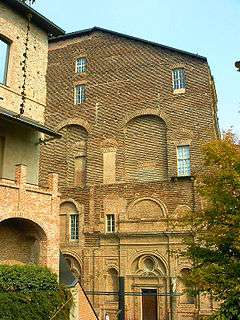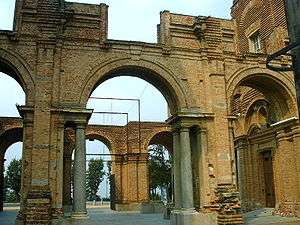Castle of Rivoli
| Castle of Rivoli | |
|---|---|
| Castello di Rivoli | |
 The castle's unfinished façade | |
| General information | |
| Town or city | Rivoli |
| UNESCO World Heritage site | |
| Criteria | (i)(ii)(iv)(v) |
| Reference | 823bis |
| Inscription | 1997 (21st Session) |

The Castle of Rivoli is a former Residence of the Royal House of Savoy in Rivoli (Metropolitan City of Turin, Italy). It is currently home to the Castello di Rivoli – Museo d'Arte Contemporanea, the museum of contemporary art of Turin.
History
The castle was probably built in the 9th–10th centuries, but its existence is mentioned for the first time only in 1159, in a diploma by Emperor Frederick Barbarossa that ceded the Rivolese territories to the bishops of Turin.
The House of Savoy acquired Rivoli in the 11th century, and soon began a feud with the bishops that as soon as 1184 resulted in damage to the castle. In 1330 Amadeus VI of Savoy moved in the castle the Consiglio dei Principi, senior administrative council of the countryside. The castle was also the first place of public veneration of the Shroud of Turin in his path towards Turin under Amadeus IX.
After a period of decline, the Treaty of Cateau-Cambrésis (1559) established that Duke Emmanuel Philibert could not reside in Turin until he had a male child. He therefore set his residency in the Castle of Rivoli, having it restored by architect Ascanio Vitozzi. In 1562 heir Charles Emmanuel I was born, and he returned to Turin. Works on Vitozzi's designs were brought on until 1644 under Carlo and Amedeo di Castellamonte, with the construction of the so-called Manica Lunga, intended to house the Savoy Gallery, the sole 17th-century part of the edifice still visible today. Numerous works of art were however stolen by French troops in the following years. New works began after 1706.
19th century onwards
Victor Amadeus II commissioned a new façade from Filippo Juvarra, but again it remained unfinished. Victor Amadeus lived here as a prisoner with his morganatic spouse the Marchesa di Spigno after his abdication and his failed attempt to regain the reign from his son Charles Emmanuel III. After his death, the castle was mostly abandoned, and in 1863 the comune of Rivoli turned it into barracks, while twenty years later a section was used as library.
The edifice was heavily damaged during World War II, and remained in a substantial state of abandon until 1979, when new works of restoration were begun. In 1984 the castle was reopened as seat of the Museo di Arte Contemporanea (Contemporary Art Museum). The castle also contains the Michelin-starred restaurant Combal.Zero.[1]
Renovation projects
The first renovation works was made by the Turin architect Andrea Bruno. Unfortunately, the initiative was not completed for the budget was only enough to repair the structure damages. A few years later, in 1967, the same Bruno proceed to break down the decaying parts of the atrium, built at the beginning of '900.[2]
Popular culture
The palace is the setting for the play King Victor and King Charles by Robert Browning.
References
- ↑ Bruni, Frank. "Cucina dell'Arte: High-End Dining in Italy". nytimes.com. The New York Times. Retrieved 1 September 2015.
- ↑ "Renovation". castellodirivoli.org. Retrieved 14 November 2016.
External links
- Official website (in English) (in Italian)
